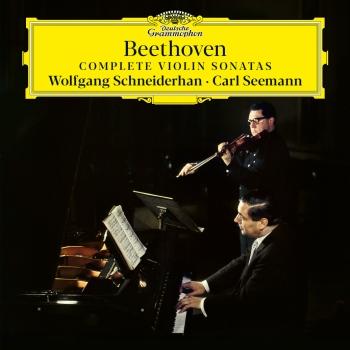Wolfgang Schneiderhan & Carl Seemann
Biography Wolfgang Schneiderhan & Carl Seemann
Wolfgang Eduard Schneiderhan
war einer de bedeutendsten österreichischen Violinvirtuosen. Geboren am 28. Mai 1915 Wien, trat er bereits mit fünf Jahren als Wunderkind in der Öffentlichkeit in Erscheinung. 1922-28 studierte er in Pisek bei Otakar Ševčík, dem Begründer der tschechisch-wienerischen Geigenschule. 1925 setzte er sein Studium bei Julius Winkler in Wien fort. Als Siebzehnjähriger wurde er Konzertmeister des Symphonie-Orchesters Wien, 1937 wurde er Konzertmeister des Orchesters der Wiener Staatsoper und schließlich von 1938 bis 1951 Konzertmeister der Wiener Philharmoniker. In der gleichen Zeit bildete er zusammen mit Otto Strasser, Ernst Morawec und Richard Krotschak das Schneiderhan-Quartett. Ab 1948 leitete er die Meisterkurse für Violine beim Internationalen Musikfest Luzern. Von 1949 bis 1956 bildete er auch zusammen mit Edwin Fischer und Enrico Mainardi eine bis heute legendäre Trio-Formation. 1956 war er Mitbegründer des Kammerorchesters Festival Strings Lucerne. Daneben unterrichtete er am Mozarteum Salzburg (1936-56), an der Wiener Musikakademie (1939-51), am Konservatorium von Luzern (ab 1949) sowie am Konservatorium Stockholm (1964). 1948 heiratete er die Sopranistin Irmgard Seefried. Die Tochter aus dieser Ehe ist die Schauspielerin Mona Seefried. Wolfgang Schneiderhan starb am 18. Mai 2002 in Wien.
Carl Seemann
completed his general education in Bremen before going on to the Institute for Church Music of the High School for Music in Leipzig, where he studied the organ with Günter Ramin and piano with Carl-Adolf Martienssen. At the start of his professional life he was an organ specialist, becoming organist at the church of St Nicholas in Flensburg and later at the cathedral at Verden on the Aller, but at the age of twenty-five Seemann decided to become a pianist and the following year began to teach at the Nordmarkmusikschule in Kiel. From 1942 he gave piano master-classes in Strasbourg where he performed the complete works of Bach in public, and after the end of World War II he joined the music staff of the Musikhochschule in Freiburg where he continued to teach until his retirement at the age of sixty-four.
The range of Seemann’s repertoire was wide, stretching from Bach and Scarlatti to the twentieth century including composers such as Stravinsky, Bartók, Hindemith and Berg, and he was the dedicatee of Hans Werner Henze’s Concertino for Piano, Winds and Percussion. Between 1952 and 1966 he worked as a duo with violinist Wolfgang Schneiderhan, enjoying great success throughout Europe, and also performed and recorded with pianist Edith Picht-Axenfeld. Seemann worked with many conductors including Otto Klemperer, Leopold Stokowski, Hans Rosbaud, Carl Schuricht, Eugen Jochum, Rudolf Kempe, István Kertész, Paul Hindemith and Igor Stravinsky. He also appeared on the juries of numerous piano competitions including the Busoni Competition in Bolzano, the ARD Competition in Munich and the German Music Competition in Bonn.
Seemann’s main recordings were made for Deutsche Grammophon during the 1950s. In September 1950 he recorded Mozart’s Piano Concerto in C major K. 503 with the Munich Philharmonic Orchestra and Fritz Lehmann. Three years later with Lehmann he recorded the Piano Concerto in D major K. 537, this time with the Berlin Philharmonic Orchestra. Both of these recordings display Seemann’s completely objective and controlled musicianship. This is ‘modern’ Mozart playing before it had become fashionable, with an emphasis on clarity, style and precision. Seemann recorded the complete piano sonatas and various short pieces by Mozart as well as two concert rondos for piano and orchestra, the Concerto for Two Pianos in E flat K. 365 (with Andor Foldes) and the Piano Concerto in C minor K. 491, again with the Berlin Philharmonic Orchestra but with Ferdinand Leitner conducting. Seemann’s clarity of style was also suited to twentieth-century music and he recorded the Concerto for Piano and Wind Instruments by Stravinsky with the Berlin Philharmonic Orchestra, and Bartók’s Sonata for Two Pianos and Percussion with Edith Picht-Axenfeld.
In addition to an excellently muscular Chromatic Fantasy and Fugue BWV 903 by Bach, evidently benefiting from his organ training, Seemann recorded solo works by Beethoven, Haydn and Mozart, and sensitive but unsentimental performances of Brahms’s Fantasien Op. 116 and Klavierstücke Op. 118 as well as a beautifully-toned Children’s Corner Suite by Debussy. All of these recordings were reissued in 1999 on four compact discs by Deutsche Grammophon in Germany as Carl Seemann Das Vermächtnis. With Schneiderhan, Seemann recorded many of Mozart’s violin sonatas, all of those by Beethoven and Brahms as well as others by Schubert, Schumann, César Franck, Richard Strauss, Prokofiev, Stravinsky, Hindemith and Bartók. All of the duo recordings have had limited release on compact disc in Japan.
The Orfeo label has issued some live material of Seemann from the Salzburg Festival, plus German radio broadcasts including Beethoven’s Piano Concerto No. 2 in B flat Op. 19 with the NDR Symphony Orchestra and István Kertész, Mozart’s Concertos K. 449 and K. 503, works by Berg and Reger and duos with Schneiderhan. Orfeo has also issued Seemann playing Bach’s complete partitas from Radio Bremen in July 1965, and in 1990 Christophorus issued Bach recordings from Radio Leipzig made in 1959 and 1960.














